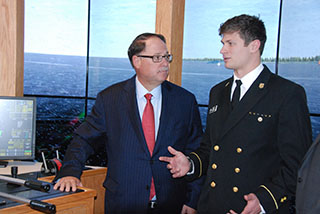The Bouchard Tug and Barge Simulation Center has expanded with the addition of two Class B tug assist simulators, allowing students at the State University of New York Maritime College and professional mariners to work together on training to dock articulated tug barges.
“With the new class B simulators combined with the Class A bridge simulators, cadets are going to be receiving a higher level of training,” said Capt. Eric Johansson, professor of marine transportation. “Recognized by the U.S. Coast Guard for its unique skill sets, tugboat training at the Bouchard Simulation Center will meet demand and exceed the expectations of cadets and seasoned mariners.”
Sponsored and supported by the Bouchard Transportation Co. Inc., Melville, N.Y., the simulator opened on the SUNY Maritime campus in the 2015 fall semester with the Class A bridge simulator, a virtual-reality machine that projects 360-degree views of U.S. harbors and waterways complete with vessel traffic and changing weather and visibility.
The new Class B simulators, set up a few steps from the bridge simulator, have five screens each and project 270 degrees of visibility for trainees. Cadets will use them to practice steering traditional tug barge units, articulated tug barges, towboats, and conventional and tractor harbor assist tugboats, and perform dockings, undockings, escort and emergency maneuvers with articulated tug barges — using all three simulators at the same time. The simulators have communications as though cadets are working on different vessels.
Bouchard president and CEO Morton S. Bouchard III saw the need for a Northeast simulation center for both students and mid-career mariners. The company provided both the $750,000 development and construction costs and ongoing software support and upgrades.
“Education is of vital importance at Bouchard, and a major aspect of education is simulator training,” Bouchard said. “It is very simple, the more educated employees are, the more inclined they will be to always operate safely. Our proud commitment to the simulator just reinforces our corporate philosophy that there is no budget for safety and proper training. Safety is our number one, top priority.”





